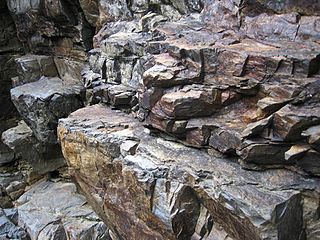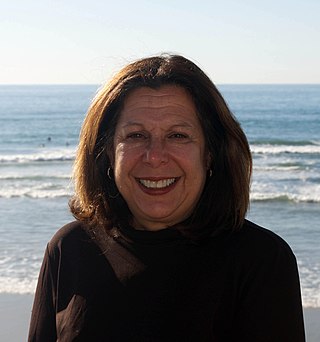Related Research Articles

The stratosphere is the second layer of the atmosphere of Earth, located above the troposphere and below the mesosphere. The stratosphere is an atmospheric layer composed of stratified temperature layers, with the warm layers of air high in the sky and the cool layers of air in the low sky, close to the planetary surface of the Earth. The increase of temperature with altitude is a result of the absorption of the Sun's ultraviolet (UV) radiation by the ozone layer. The temperature inversion is in contrast to the troposphere, near the Earth's surface, where temperature decreases with altitude.

The atmosphere of Earth is the layer of gases, known collectively as air, retained by Earth's gravity that surrounds the planet and forms its planetary atmosphere. The atmosphere of Earth creates pressure, absorbs most meteoroids and ultraviolet solar radiation, warms the surface through heat retention, allowing life and liquid water to exist on the Earth's surface, and reduces temperature extremes between day and night.

Radiative forcing is the change in energy flux in the atmosphere caused by natural or anthropogenic factors of climate change as measured in watts per meter squared. It is a scientific concept used to quantify and compare the external drivers of change to Earth's energy balance. These external drivers are distinguished from climate feedbacks and internal variability, which also influence the direction and magnitude of imbalance.

Oxygen cycle refers to the movement of oxygen through the atmosphere (air), biosphere (plants and animals) and the lithosphere (the Earth’s crust). The oxygen cycle demonstrates how free oxygen is made available in each of these regions, as well as how it is used. The oxygen cycle is the biogeochemical cycle of oxygen atoms between different oxidation states in ions, oxides, and molecules through redox reactions within and between the spheres/reservoirs of the planet Earth. The word oxygen in the literature typically refers to the most common oxygen allotrope, elemental/diatomic oxygen (O2), as it is a common product or reactant of many biogeochemical redox reactions within the cycle. Processes within the oxygen cycle are considered to be biological or geological and are evaluated as either a source (O2 production) or sink (O2 consumption).

Paul Jozef Crutzen was a Dutch meteorologist and atmospheric chemist. He was awarded the Nobel Prize in Chemistry in 1995 for his work on atmospheric chemistry and specifically for his efforts in studying the formation and decomposition of atmospheric ozone. In addition to studying the ozone layer and climate change, he popularized the term Anthropocene to describe a proposed new epoch in the Quaternary period when human actions have a drastic effect on the Earth. He was also amongst the first few scientists to introduce the idea of a nuclear winter to describe the potential climatic effects stemming from large-scale atmospheric pollution including smoke from forest fires, industrial exhausts, and other sources like oil fires.

Aeronomy is the scientific study of the upper atmosphere of the Earth and corresponding regions of the atmospheres of other planets. It is a branch of both atmospheric chemistry and atmospheric physics. Scientists specializing in aeronomy, known as aeronomers, study the motions and chemical composition and properties of the Earth's upper atmosphere and regions of the atmospheres of other planets that correspond to it, as well as the interaction between upper atmospheres and the space environment. In atmospheric regions aeronomers study, chemical dissociation and ionization are important phenomena.

The following outline is provided as an overview of and topical guide to Earth science:

Susan Solomon is an American atmospheric chemist, working for most of her career at the National Oceanic and Atmospheric Administration. In 2011, Solomon joined the faculty at the Massachusetts Institute of Technology, where she serves as the Ellen Swallow Richards Professor of Atmospheric Chemistry & Climate Science. Solomon, with her colleagues, was the first to propose the chlorofluorocarbon free radical reaction mechanism that is the cause of the Antarctic ozone hole.

Earth science or geoscience includes all fields of natural science related to the planet Earth. This is a branch of science dealing with the physical, chemical, and biological complex constitutions and synergistic linkages of Earth's four spheres: the biosphere, hydrosphere/cryosphere, atmosphere, and geosphere. Earth science can be considered to be a branch of planetary science, but with a much older history.
Darin W. Toohey is an American atmospheric scientist. He is a professor of atmospheric and oceanic sciences and of environmental studies at the University of Colorado Boulder since 1999. Toohey's research addresses the role of trace gases and aerosols on Earth's climate, atmospheric oxidation, and air quality. He was a Jefferson Science Fellow at the United States Department of State, 2011-2012.
David C. Catling is a Professor in Earth and Space Sciences at the University of Washington. He is a planetary scientist and astrobiologist whose research focuses on understanding the differences between the evolution of planets, their atmospheres, and their potential for life. He has participated in NASA's Mars exploration program and contributed research to help find life elsewhere in the solar system and on planets orbiting other stars. He is also known for his work on the evolution of Earth's atmosphere and biosphere, including how Earth's atmosphere became rich in oxygen, allowing complex life to evolve, and conditions conducive to the origin of life.
Shuhei Ono is a professor of earth, atmospheric, and planetary sciences at the Massachusetts Institute of Technology. In his research, he measures isotopes of sulfur and other elements to investigate water-rock-microbe interactions, seafloor hydrothermal systems, the deep biosphere, and global sulfur cycles.

Vicki H. Grassian is a distinguished professor in the department of chemistry and biochemistry at the University of California, San Diego. She also holds the distinguished chair in physical chemistry.
Lisa Welp is a biogeochemist who utilizes stable isotopes to understand how water and carbon dioxide are exchanged between the land and atmosphere. She is a professor at Purdue University in the department of Earth, Atmosphere, and Planetary Sciences.
Caroline Masiello is a biogeochemist who develops tools to better understand the cycling and fate of globally relevant elemental cycles. She is a professor at Rice University in the Department of Earth, Environmental and Planetary Sciences and holds joint appointments in the Chemistry and Biochemistry Departments. Masiello was elected as a Fellow of the Geological Society of America in 2017. She currently leads an interdisciplinary team of scientists who are developing microbial sensors for earth system science.
Arlene M. Fiore is an atmospheric chemist whose research focuses on issues surrounding air quality and climate change.
Akkihebbal Ramaiah (Ravi) Ravishankara ForMemRS FAAAS FRSC is a scientist specializing in Chemistry and Atmospheric Sciences, and University Distinguished Professor in the Departments of Chemistry and Atmospheric Sciences at Colorado State University, Fort Collins.
Meredith G. Hastings is an American atmospheric chemist and associate professor of earth, environmental, and planetary sciences at Brown University. Her research focuses on the reactive nitrogen cycle and how atmospheric chemistry affects climate. She is also the founder and president of the Earth Science Women’s Network.
Jennifer G. Murphy is a Canadian environmental chemist and an associate professor at the University of Toronto. She is known for her research how air pollutants such as increased reactive nitrogen affect the global climate.
Mark Howard Thiemens is a distinguished professor and the John Doves Isaacs Endowed Chair in Natural Philosophy of Physical Sciences in the department of chemistry and biochemistry at the University of California San Diego. He is best known for the discovery of a new physical chemical phenomena termed the mass independent isotope effect.
References
- 1 2 3 4 5 6 "WEDDINGS; Kristie Boering, Ronald Cohen". The New York Times. 1998-01-18. ISSN 0362-4331 . Retrieved 2019-05-04.
- 1 2 3 4 5 6 7 8 9 10 11 "Kristie A. Boering | College of Chemistry". chemistry.berkeley.edu. Retrieved 2019-05-04.
- ↑ Boering, Kristie A.; Thiemens, Mark H.; Bender, Michael L.; Barkan, Eugeni; Luz, Boaz (1999). "Triple-isotope composition of atmospheric oxygen as a tracer of biosphere productivity". Nature. 400 (6744): 547–550. Bibcode:1999Natur.400..547L. doi:10.1038/22987. ISSN 1476-4687. S2CID 4345679.
- ↑ "Professor Boering's New Article in GRL". Earth and Planetary Science. 2016-02-25. Retrieved 2019-05-04.
- ↑ Hall, Timothy M.; Waugh, Darryn W.; Boering, Kristie A.; Plumb, R. Alan (1999). "Evaluation of transport in stratospheric models". Journal of Geophysical Research: Atmospheres. 104 (D15): 18815–18839. Bibcode:1999JGR...10418815H. doi:10.1029/1999JD900226. ISSN 2156-2202.
- 1 2 "Kristie Boering | Research UC Berkeley". vcresearch.berkeley.edu. Retrieved 2019-05-04.
- ↑ Zumdahl, Steven S.; DeCoste, Donald J. (2012-01-01). Chemical Principles. Cengage Learning. ISBN 9781111580650.
- ↑ "Center for Integrative Planetary Science | Research UC Berkeley". vcresearch.berkeley.edu. Retrieved 2019-05-04.
- 1 2 3 "Fertilizer use responsible for increase in nitrous oxide in atmosphere | Research UC Berkeley". vcresearch.berkeley.edu. Retrieved 2019-05-04.
- ↑ "PAOC Colloquium - Kristie A. Boering (UC Berkeley) | MIT Department of Earth, Atmospheric and Planetary Sciences". eapsweb.mit.edu. Retrieved 2019-05-04.
- ↑ "ELSI". www.elsi.jp. Retrieved 2019-05-04.
- ↑ "Boering, Kristie A." The David and Lucile Packard Foundation. Retrieved 2019-05-04.
- ↑ "Professor Kristie Boering received the Camille Dreyfus Teacher-Scholar Award". Earth and Planetary Science. 2013-04-08. Retrieved 2019-05-04.
- ↑ Sanders, Robert (2018-05-01). "National Academy of Sciences adds five Berkeley faculty members to its ranks". Berkeley News. Retrieved 2019-05-04.
- ↑ "Kristie Boering". www.nasonline.org. Retrieved 2019-05-04.
- ↑ "2021 Class of AGU Fellows Announced". Eos. 28 September 2021. Retrieved 2021-09-29.
- ↑ "Science and love". The Berkeley Science Review. 2012-01-16. Retrieved 2019-05-04.
- ↑ "Boering profile". Finding Your Balance. Retrieved 2019-05-04.